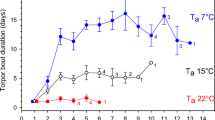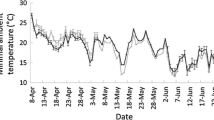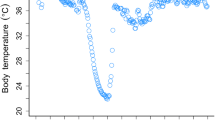Abstract
One of the most obvious physiological changes accompanying seasonal heterothermy in mammals is a fattening stage preceding periods of resource scarcity. This phenomenon reflects the interplay of both diet and physiology. Though the accrual of fat stores is known to be essential for overwintering in some species, the influence of diet on the physiology of torpor is not fully understood. Results from captive studies in heterothermic rodents and marsupials have indicated that when autumn diets are enriched with polyunsaturated fatty acids (PUFAs), animals receiving these diets experience deeper and more frequent torpor bouts than their counterparts receiving a control diet. Our study investigates this potential effect of dietary composition in animals that use daily torpor rather than prolonged torpor (i.e., hibernation). In so doing, we investigate the degree to which dietary effects on torpor are restricted to cold-adapted rodents and marsupials, or are a more general feature of mammalian heterothermy. We examined the effects of a PUFA diet and a control diet on the thermoregulation of one of the few species of primates known to use daily torpor: the grey mouse lemur (Microcebus murinus). Though the results of this study are largely inconclusive regarding the impact of dietary manipulations on torpor frequency and duration, we nonetheless find that the propensity of animals to enter torpor is directly influenced by age and seasonal changes in body mass, and thus reflect important physiological aspects of flexible thermoregulatory responses.






Similar content being viewed by others
References
Atsalis S (1999) Seasonal fluctuations in body fat and activity levels in a rain-forest species of mouse lemur, Microcebus rufus. Int J Primatol 20:883–910
Aujard F, Perret M, Vannier G (1998) Thermoregulatory responses to variations of photoperiod and ambient temperature in the male lesser mouse lemur: a primitive or an advanced adaptive character? J Comp Physiol B 168:540–548
Bartness TJR, Milner R, Geloen A, Trayhurn P (1991) Effects of high fat diets on hibernation and adipose tissue in Turkish hamsters. J Comp Pysiol B 161:451–459
Bates D, Mächler M, Bolker B, Walker S (2015) Fitting linear mixed-effects models using lme4. J Stat Soft. 67:5. doi:10.18637/jss.v067.i01
Boyer B, Barnes B (1999) Molecular and metabolic aspects of mammalian hibernation. Bioscience 49:713–724
Carey H, Andrews M, Martin S (2003) Mammalian hibernation: cellular and molecular responses to depressed metabolism and low temperature. Physiol Rev 83:1153–1181. doi:10.1152/physrev.00008.2003
Contreras C, Franco M, Place NJ, Nespolo RF (2014) The effects of poly-unsaturated fatty acids on the physiology of hibernation in a South American marsupial, Dromiciops gliroides. Comp Biochem Physiol 177:62–69. doi:10.1016/j.cbpa.2014.07.004
Corn JG (1997) The role of polyunsaturated fats in hibernation and daily torpor. Ph.D. disseration. Colorado State University
Dark J (2005) Annual lipid cycles in hibernators: integration of physiology and behavior. Annu Rev Nutr 25:469–497. doi:10.1146/annurev.nutr.25.050304.092514
Dausmann K (2005) Measuring body temperature in the field—evaluation of external vs. implanted transmitters in a small mammal. J Therm Biol 30:195–202. doi:10.1016/j.jtherbio.2004.11.003
Dausmann K, Glos J, Ganzhorn J, Heldmaier G (2005) Hibernation in the tropics: lessons from a primate. J Comp Physiol B 175:147–155. doi:10.1007/s00360-004-0470-0
Diedrich V, Steinlechner S, Scherbarth F (2014) Effects of unsaturated fatty acids on torpor frequency and diet selection in Djungarian hamsters (Phodopus sungorus). J Exp Biol 217:4313–4319. doi:10.1242/jeb.113217
Fietz J, Tataruch F, Dausmann K, Ganzhorn J (2003) White adipose tissue composition in the free-ranging fat-tailed dwarf lemur (Cheirogaleus medius; Primates), a tropical hibernator. J Comp Physiol B 173:1–10. doi:10.1007/s00360-002-0300-1
Florant G (1998) Lipid metabolism in hibernators: the importance of essential fatty acids. Am Zoologist 38:331–340
Florant GL, Hester L, Ameenuddin S, Rintoul DA (1993) The effect of a low essential fatty acid diet on hibernation in marmots. Am J Physiol 264:R747–R753
Frank CL (1991) Adaptations for hibernation in the depot fats of a ground squirrel (Spermophilus beldingi). Can J Zool 69:2707–2711
Frank CL (1992) The influence of dietary fatty-acids on hibernation by golden-mantled ground squirrels (Spermophilus lateralis). Physiol Zool 65:906–920
Frank CL (2002) Short-term variations in diet fatty acid composition and torpor by ground squirrels. J Mammal 83(4):1013–1019
Frank C, Dierenfeld E (1998) The relationship between lipid peroxidation, hibernation, and food selection in mammals. Am Zool 38:341–349
Frank CL, Storey KB (1996) The effect of total unsaturate content on hibernation. In: Geiser F, Hulbert AJ, Nicol SC (eds) Adaptations to the cold: 10th international hibernation symposium, University of New England Press, Armidale, pp 211–216
Frankel EN (1995) Oxidation of polyunsaturated lipids and its nutritional consequences. In: Castenmiller WAM (ed) Oils-fats-lipids: proceedings of the 21st World Congress of the International Society for Fat Research (ISF)
Geiser F (1990) Influence of polyunsaturated and saturated dietary lipids on adipose tissue, brain and mitochondrial membrane fatty acid composition of a mammalian hibernator. Biochim Biophys Acta 1046:159–166
Geiser F (1991) The effect of unsaturated and saturated dietary lipids on the pattern of daily torpor and the fatty acid composition of tissues and membranes of the deer mouse Peromyscus maniculatus. J Comp Physiol B 161:590–597
Geiser F, Heldmaier G (1995) The impact of dietary fats, photoperiod, temperature and season on morphological variables, torpor patterns, and brown adipose tissue fatty acid composition of hamsters, Phodopus sungorus. J Comp Physiol B
Geiser F, Kenagy GJ (1987) Polyunsaturated lipid diet lengthens torpor and reduces body temperature in a hibernator. Am J Physiol 252:R897–R901
Geiser F, Ruf T (1995) Hibernation versus daily torpor in mammals and birds: physiological variables and classification of torpor patterns. Physiol Zool 68:935–966
Geiser F, Ruf T (2015) Daily torpor and hibernation in birds and mammals. Biol Rev 90:891–926. doi:10.1111/brv.12137
Geiser F, Hiebert S, Kenagy G (1990) Torpor bout duration during the hibernation season of two sciurid rodents: interrelations with temperature and metabolism. Physiol Zool 63:489–503
Geiser F, Stahl B, Learmonth R (1992) The dffect of dietary fatty-acids on the pattern of torpor in a marsupial. Physiol Zool 65:1236–1245
Geiser F, Mcallan BM, Kenagy GJ (1994) The degree of dietary fatty acid unsaturation affects torpor patterns and lipid composition of a hibernator. J Comp Physiol B 164:299–305
Geiser F, Kenagy GJ, Wingfield JC (1997) Dietary cholesterol enhances torpor in a rodent hibernator. J Comp Physiol B 167:416–422
Geiser F, Holloway JC, Körtner G (2007) Thermal biology, torpor and behaviour in sugar gliders: a laboratory-field comparison. J Comp Physiol B 177:495–501. doi:10.1007/s00360-007-0147-6
Genin F, Perret M (2000) Photoperiod-induced changes in energy balance in gray mouse lemurs. Physiol Behav 71:315–321
Genin F, Perret M (2003) Daily hypothermia in captive grey mouse lemurs (Microcebus murinus): effects of photoperiod and food restriction. Comp Biochem Physiol B 136:71–81. doi:10.1016/S1096-4959(03)00172-6
Giroud S, Blanc S, Aujard F et al (2008) Chronic food shortage and seasonal modulations of daily torpor and locomotor activity in the grey mouse lemur (Microcebus murinus). AJP Reg Integ Comp Physiol 294:R1958–R1967. doi:10.1152/ajpregu.00794.2007
Gunstone ED, Harwood JL, Padley FB (1986) The lipid handbook. Chapman and Hall, New York, pp 265–270
Halliwell B, Gutteridge J (1986) Oxygen free-radicals and iron in relation to biology and medicine: some problems and concepts. Arch Biochem Biophys 246:501–514
Harlow HJ, Frank CL (2001) The role of dietary fatty acids in the evolution of spontaneous and facultative hibernation patterns in prairie dogs. J Comp Physiol B 171:77–84. doi:10.1007/s003600000148
Hazel JR, Williams EE (1980) The role of alterations in membrane lipid composition in enabling physiological adaptation of organisms to their physical environment. Prog Lipid Re 29(3):167–227
Heldmaier G, Ortmann S, Elvert R (2004) Natural hypometabolism during hibernation and daily torpor in mammals. Resp Physiol Neurobi 141(3):317–329. doi:10.1016/j.resp.2004.03.014
Hiebert SM, Fulkerson EK, Lindermayer KT, McClure SD (2000) Effect of temperature on preference for dietary unsaturated fatty acids in the Djungarian hamster (Phodopus sungorus). Can J Zool 78:1361–1368
Kobbe S, Ganzhorn JU, Dausmann KH (2011) Extreme individual flexibility of heterothermy in free-ranging Malagasy mouse lemurs (Microcebus griseorufus). J Comp Physiol B 181:165–173. doi:10.1007/s00360-010-0507-5
Kronfeld-Schor N, Dayan T (2013) Thermal ecology, environments, communities, and global change: energy intake and expenditure in endotherms. Annu Rev Ecol Evol Syst 44:461–480. doi:10.1146/annurev-ecolsys-110512-135917
Levin E, Yom-Tov Y, Hefez A, Kronfeld-Schor N (2013) Changes in diet, body mass and fatty acid composition during pre-hibernation in a subtropical bat in relation to NPY and AgRP expression. J Comp Physiol B 183:157–166. doi:10.1007/s00360-012-0689-0
Munro D, Thomas DW (2004) The role of polyunsaturated fatty acids in the expression of torpor by mammals: a review. Zoology 107:29–48. doi:10.1016/j.zool.2003.12.001
Munro D, Thomas D, Humphries M (2005) Torpor patterns of hibernating eastern chipmunks (Tamias striatus) vary in response to the size and fatty acid composition of food hoards. J Anim Ecology 74:692–700. doi:10.1111/j.1365-2656.2005.00968.x
Nowack J, Mzilikazi N, Dausmann KH (2010) Torpor on demand: heterothermy in the non-lemur primate, Galago moholi. PLoS One 5:e10797. doi:10.1371/journal.pone.0010797
Nowack J, Whippich M, Mzilikazi N, Dausmann KH (2013) Surviving the cold, dry period in Africa: behavioral adjustments as an alternative to teterothermy in the African Lesser Bushbaby (Galago moholi). Int J Primatol 34:49–64. doi:10.1007/s10764-012-9646-8
Ortmann S, Heldmaier G, Schmid J, Ganzhorn JU (1997) Spontaneous daily torpor in Malagasy mouse lemurs. Naturwissenschaften 84:28–32
Perret M, Aujard F, Vannier G (1998) Influence of daylength on metabolic rate and daily water loss in the male prosimian primate Microcebus murinus. Comp Biochem Physiol A 119:981–989
R Core Team (2015) R: a language and environment for statistical computing. R Foundation for Statistical Computing, Vienna, Austria. http://www.R-project.org/
Schmid J (1999) Sex-specific differences in activity patterns and fattening in the gray mouse lemur (Microcebus murinus) in Madagascar
Schmid J (2000) Torpor in the tropics: the case of the gray mouse lemur. Basic Appl Ecol 1:133–139
Schmid J (2001) Daily torpor in free-ranging gray mouse lemurs (Microcebus murinus) in Madagascar. Int J Primatol 22:1021–1031
Schmid J, Ganzhorn JU (2009) Optional strategies for reduced metabolism in gray mouse lemurs. Naturwissenschaften 96:737–741. doi:10.1007/s00114-009-0523-z
Schülke O, Ostner J (2007) Physiological ecology of cheirogaleid primates: variation in hibernation and torpor. Acta Ethol 10:13–21. doi:10.1007/s10211-006-0023-5
Seguy M, Perret M (2004) Factors affecting the daily rhythm of body temperature of captive mouse lemurs (Microcebus murinus). J Comp Physiol B 175:107–115. doi:10.1007/s00360-004-0467-8
Seppanen CM, Cho H, Csallany AS (2013) Comparison between high-PUFA and low-PUFA fats on lipid peroxidation and LDL oxidation. FNS 04:572–579. doi:10.4236/fns.2013.45074
Stawski C, Geiser F (2010) Fat and fed: frequent use of summer torpor in a subtropical bat. Naturwissenschaften 97:29–35. doi:10.1007/s00114-009-0606-x
Thorp CR, Ram PK, Florant GL (1994) Diet alters metabolic rate in the yellow-bellied marmot (Marmota flaviventris) during hibernation. Physiol Zool 67:1213–1229
Vuarin P, Henry PY, Guesnet P, Alessandri JM, Aujard F, Perret M, Pifferi F (2014) Shallow hypothermia depends on the level of fatty acid unsaturation in adipose and liver tissues in a tropical heterothermic primate. J Therm Biol 43:81–88. doi:10.1016/j.jtherbio.2014.05.002
Vuarin P, Henry PY, Perret M, Pifferi F (2016) Dietary supplementation with n-3 polyunsaturated fatty acids reduces torpor use in a tropical daily heterotherm. Physiol Biochem Zool. doi:10.1086/688659
Withers K, Billingsley J, Hirning D, Young A, McConnell P, Carlin S (1996) Torpor in Sminthopsis macroura: effects of dietary fatty acids. In: Geiser F, Hulbert, AJ, Nicol SJ ( eds) Adaptations to the cold. University of New England Press, Armidale, Australia, pp 217–222
Acknowledgements
We thank Sarah Zehr and Kathrin Dausmann for careful review of the manuscript and appreciate the assistance of Duke Lemur Center staff, especially Erin Ehmke, David Brewer, and Bobby Schopler for making this project possible. We would especially like to thank Edwin Iversen and the Duke Statistical Computing Center for guidance on statistical analysis. This is Duke Lemur Center publication number 1334. This work was supported by grants from the Mazuri Exotic Animal Nutrition Grant to S.L.F., and a National Science Foundation Doctoral Research Improvement Grant [NSF-BCS 1455809 to A.D.Y and S.L.F].
Author information
Authors and Affiliations
Corresponding author
Ethics declarations
All procedures performed in studies involving animals were in accordance with the ethical standards of the institution at which the studies were conducted. Animal handling was carried out with the approval of Duke University’s Institutional Animal Care and Use Committee (IACUC Protocol #A146-12-05). The authors declare no competing interests.
Additional information
Communicated by G. Heldmaier.
Electronic supplementary material
Below is the link to the electronic supplementary material.
Rights and permissions
About this article
Cite this article
Faherty, S.L., Campbell, C.R., Hilbig, S.A. et al. The effect of body mass and diet composition on torpor patterns in a Malagasy primate (Microcebus murinus). J Comp Physiol B 187, 677–688 (2017). https://doi.org/10.1007/s00360-016-1045-6
Received:
Revised:
Accepted:
Published:
Issue Date:
DOI: https://doi.org/10.1007/s00360-016-1045-6




